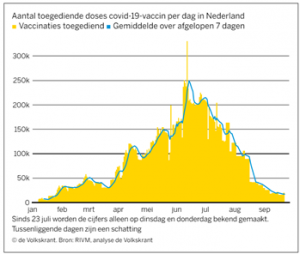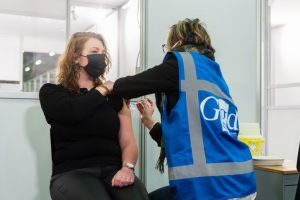Symbol helps GGD increase vaccination rate
Substantially increase the speed at which corona vaccines are set. That was the task for which GGD GHOR, the umbrella trade association of the 25 Municipal Health Services, enlisted Symbol’s help.
“The question was whether we could form a Lean team to increase the efficiency of the pricking locations in the Netherlands,” says director and founder of Symbol Dick Theisens.
A social crisis of unprecedented proportions. It is no exaggeration to describe the corona pandemic that way. The country went into lockdown, hospitals were overcrowded and more than a year and a half after the first cases, the effects are still being felt. Several corona vaccines were rushed through development and became available within a year of the start of the pandemic. In 9 months, GGDs did the vast majority of the 23 million pricks. An unprecedented logistical achievement. Some 85% of the 18+ population has since gotten their first shot. At its peak, in week 24, 250,000 punctures per day were made. As mentioned, an unprecedented logistical achievement. This article about Symbol’s contribution to it provides a behind-the-scenes look at the process.

The number of vaccinations administered over time
Working toward peak capacity of 2 million pricks per week
Early in the vaccination process, vaccine availability was the bottleneck. But it was also clear that sufficient vaccine would be available at some point. “We were working toward peak capacity of the requested two million pricks per week,” says Abe Deurloo, principal on behalf of GGD GHOR. “We noticed that there was a lot of difference between the regions in how fast the poking was done. The trade association decided to look for a party specialized in optimizing processes and transferring knowledge. ‘A party who could help us map out how the processes were running at that point, who could identify what could be improved and who could communicate that widely.’
Following a tender process, Symbol was asked in early May to form a Lean team, of five consultants, to support the regions in increasing puncture efficiency. So at that time, the vaccination campaign had been underway for several months and about 500,000 punctures per week were being done. Within a few weeks, there should be three to four times as many.

Vaccinating against corona at the GGD
Focus on the workplace
Theisens himself assumed the role of Product Owner. “In that role, I was in constant contact with the client and translated the requirements of that day’s challenges into activities for the Lean team.” Each morning began with a central day-start meeting. In this online meeting, in which all disciplines including IT, HR, Logistics, Medical, Communications and the Call Center were represented, the state of affairs was discussed and challenges were identified. The Lean team was part of the logistics team, whose main challenge was to ensure the availability of sufficient vaccines, on the one hand, and, on the other hand, to ensure that these vaccines were snuffed out at an ever-increasing rate. The Lean team’s assignment was to support the GGDs in process optimization where needed so that vaccination sites would be ready for the June peak.
Commissioned by GGD GHOR, the 25 regions had sought and set up their own vaccination sites. Most of the sites had been designed or realized before May. So it was not possible to proceed to a completely different design yet.
A key Lean principle applied by the team is to focus attention where it happens: the “Gemba. Improvement and support does not take place from behind a desk, but on the shop floor. “In our approach, the ‘Gemba visits’ have had a central role,” Theisens said. “We visited 50 of the final 150 vaccination sites in six weeks.”
Jan Alexander Knol, Lead consultant at Symbol continues: “For example, I was present at a day start in Middelburg in the morning, then on location in Goes. On other days I got to help out at the XL location in the Jaarbeurs in Utrecht. The first thing you do during a location visit is look together at ‘Natural Wayfinding’, or organizing that visitors can find their way in a natural way, for example by making sure there are few obstructions in sightlines. Small improvements we have made on site, such as adjusting walking lines, adding arrows and implementing Lean techniques such as Kanban cards for calling out new vaccines.” In addition to on-site modifications, advice was provided on improvements that could be made by the sites themselves in a few days with relatively little effort. “Think about balancing work between workstations, visualizations, work meetings, schedule planning and rearranging a picket line,” Knol said. Space for very large and drastic adjustments, by the way, was not available. The venues were already set up and by now there was a steady stream of visitors. A little better every day.
Sharing knowledge
An important part of the Lean team’s approach was to share so-called process options (“Best Practices”) within the GGDs between the different vaccination sites. If a consultant from the Lean team came across something during a site visit that was of interest to the other sites, it was worked out as a process option. Examples included inventive ways to promote visitor flow or Kanban signals to prevent a prick from running out of vaccine. In Lean terms, this is also called a 1-point lesson. This is one A4 sheet, with a photo and brief description. On a weekly basis, these Best Practices were presented in the consultation with the site heads.
“In early May, the rate was about 22 punctures per hour per puncture line,” Theisens said. “During the week of June 7, 1.4 million punctures were taken per week, and in some locations, the puncture rate had reached 50 per hour per puncture line.” Theisens continues: “What stood out was the tremendous commitment and enthusiasm we encountered at all locations. Many thousands of people were recruited in a short period of time by the various GGDs to carry out the vaccination process. Everyone felt he or she was contributing to solving the corona crisis.
On behalf of GGD GHOR, Deurloo also looks back on the cooperation with Symbol with a positive feeling. “When we started this process, there was a big difference between the sites. Some were doing fine and needed little or no support. Others were very happy with the help given to them by the Lean team. In addition to increasing vaccination rates, they also got employees excited and showed them how to make changes in the short term. The support of the Lean team made a significant contribution in the numbers we punched out in June. I liked that it was a diverse team. They were all Black Belts, of course, but all with different backgrounds,” Deurloo continued. “They communicate pleasantly and many initiatives also came from them. And Dick is still available to spar on topics. That’s very pleasant.”
Design based on ‘lessons learned’
After the peak in week 24, the pressure slowly declined again. By September, some 85% of Dutch people over 18 had their first shot, and many locations have since scaled down or closed. Still, the work for the GGD core team is not over. The3rd prick vaccinations have begun and plans are being made in case another mass vaccination (called boosters but also possibly other than Corona vaccines) is required. At the end of the project, Symbol’s consultants developed a design for the reference site, based on all the lessons learned from the last campaign. This design will be used in case mass vaccination is needed again. We hope that if the need arises again the GGDs can once again take the logistics and overall approach up a few levels.
Want to know more?
Want to learn more about Symbol’s project approach? Then contact us at 053 – 20 30 240 or using the form below. Do you want to train yourself in process optimization? Then check out our Lean Green Belt and Lean Black Belt training courses!